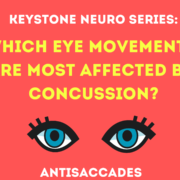Concussion and Eye Movement Series Part 1: Anti-Saccades

Eye movements have become an important diagnostic for patients with neurological disease and dysfunction. It’s one of the reasons we have invested into using extremely sophisticated eye tracking technology so that we can asses and manage patients effectively with traumatic brain injuries.
This will be the first in a series of posts about eye movements that are commonly affected with concussion. The first eye movement we’ll discuss is called anti-saccades.
What’s A Saccade?
In order to know what an anti-saccade is, we have to know what a regular saccade is. A saccade is a fast eye movement that takes your eyes from one target to another. Saccades are the eye movements we use to explore the world around us. They are also eye movements that react very quickly to new things in our environment. These can be a movement in the background, a flashing light, a loud noise, or a touch on our skin.
When we perceive there’s something in our environment that needs our attention, we use saccades almost like a reflex to direct our brain’s attention toward that new stimulus.
What’s an Anti-Saccade
An anti-saccade is a concept developed to see if someone can consciously inhibit a desire to look at something new. During an anti-saccade, we would have you fixate on a central target, and when a new target comes up, we ask you to move your eyes in a spot opposite to where the new target appeared.

Antisaccades require our brain 🧠 to ignore a new stimulus and to create a plan to move the eyes 👀 to a mirror location.
This task requires higher level brain activity because our brains are wired to look at new stimuli. Specifically it requires a functioning prefrontal cortex (PFC).
In patients with concussion, their ability to perform Anti-saccades is compromised where they make frequent eye movements towards the new target, or they take a long time to move their eyes in the opposite direction. This indicates problems with a function called response inhibition. It’s the ability for our brain to stop doing something we don’t want it to do.
This requires a part of our brain called the pre-frontal cortex. Specifically, the dorsolateral prefrontal cortex. We’ll just call it the PFC for short. The PFC is what allows us to inhibit a desire to do something that may be inappropriate.
We need our PFC to stop ourselves from making inappropriate reactions. It’s one of the main differences between an adult brain and a child’s brain is that our PFC keeps us from having meltdowns when something goes wrong.
Parents of toddlers, you guys know what I’m talking about.

So when we take a hit to the head and our PFC goes down, we can have responses that aren’t appropriate. This might mean an emotional outburst, or problems controlling wreckless behavior like uncontrolled gambling. A viable PFC is critical for that and for keeping our bodies from over reacting to stress.
This provides us a meaningful way to assess PFC activity and gives us an way to improve PFC activity using eye movement therapies.

Not only can anti-saccades be used to assess the functionality of someone’s PFC. It can play a role in helping someone rehabilitate their PFC or other aspects of the brain connected to it.


